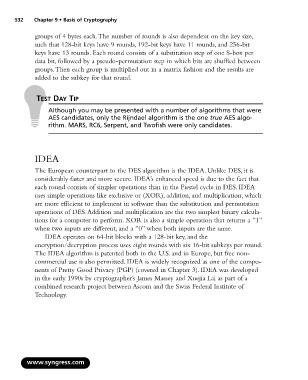Page 548 - StudyBook.pdf
P. 548
532 Chapter 9 • Basis of Cryptography
groups of 4 bytes each.The number of rounds is also dependent on the key size,
such that 128-bit keys have 9 rounds, 192-bit keys have 11 rounds, and 256-bit
keys have 13 rounds. Each round consists of a substitution step of one S-box per
data bit, followed by a pseudo-permutation step in which bits are shuffled between
groups.Then each group is multiplied out in a matrix fashion and the results are
added to the subkey for that round.
TEST DAY TIP
Although you may be presented with a number of algorithms that were
AES candidates, only the Rijndael algorithm is the one true AES algo-
rithm. MARS, RC6, Serpent, and Twofish were only candidates.
IDEA
The European counterpart to the DES algorithm is the IDEA. Unlike DES, it is
considerably faster and more secure. IDEA’s enhanced speed is due to the fact that
each round consists of simpler operations than in the Fiestel cycle in DES. IDEA
uses simple operations like exclusive or (XOR), addition, and multiplication, which
are more efficient to implement in software than the substitution and permutation
operations of DES.Addition and multiplication are the two simplest binary calcula-
tions for a computer to perform. XOR is also a simple operation that returns a ”1”
when two inputs are different, and a ”0” when both inputs are the same.
IDEA operates on 64-bit blocks with a 128-bit key, and the
encryption/decryption process uses eight rounds with six 16-bit subkeys per round.
The IDEA algorithm is patented both in the U.S. and in Europe, but free non-
commercial use is also permitted. IDEA is widely recognized as one of the compo-
nents of Pretty Good Privacy (PGP) (covered in Chapter 3). IDEA was developed
in the early 1990s by cryptographer’s James Massey and Xuejia Lai as part of a
combined research project between Ascom and the Swiss Federal Institute of
Technology.
www.syngress.com

